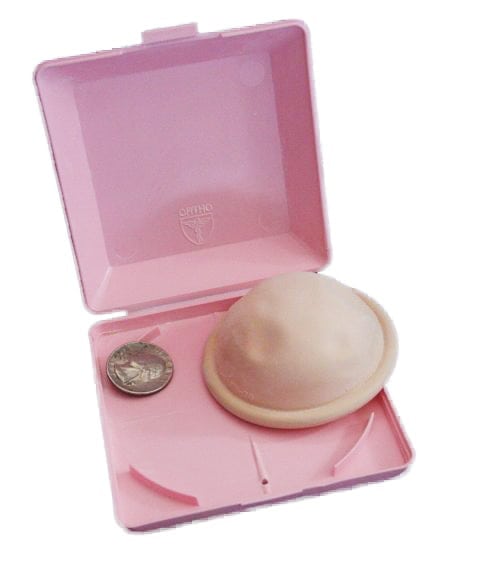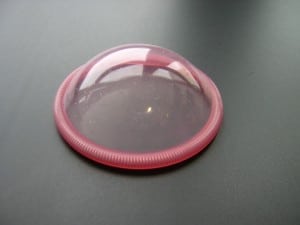Birth Control 101 is a multi-part series covering everything you need to know about birth control. It has all the details you need to make the best decision for your body, like how each method works, the pros and cons, effectiveness, cost and where to get them. After we’re done, you’ll basically be an expert, and you’ll definitely be able to make an informed decision about how to stay safe when you’re having sex.
This segment covers everything you need to know about the Diaphragm, a Barrier Method beyond condoms.
Check out our Birth Control 101 section for details on every birth control method, and Birth Control Basics for a quick and dirty overview.
Diaphragm
What is it?
The diaphragm is a small cup made of soft latex or silicone, very similar to the cervical cap, but with a different design. It is a shallow, dome-shaped cup with a flexible rim that fits over your cervix. It does not have a removal strap at the top, but is still fitted by a doctor to fit perfectly over your cervix with suction. It is a bit smaller than the cervical cap, about an inch and a half wide but only a half inch high.
How does it work?
Like the cervical cap, diaphragms help to prevent pregnancy by covering the cervix and keeping sperm away from your uterus. To be effective, it must be used with spermicide, which kills the sperm and prevents it from moving. The diaphragm is placed over the cervix before sex and suction keeps it in place. The diaphragm does not protect against HIV and STIs, so use a condom for additional protection. It should also be replaced each year.
How to Put in a Diaphragm
Your diaphragm can be inserted hours before sex, and up until the moment of sex. But, it takes a bit of preparation and work to get it in, so you may want to put it in before you’re in the heat of the moment. It takes a bit of practice to put in just right. Also, remember not you use oil based lubricants, as they can degrade the material.
To put in your diaphragm:
- First, check your diaphragm for holes, tears, or weak spots. An easy way to do this is to fill it with water and make sure it doesn’t leak. You can also hold it up to light, and see if any shines through more than normal. Don’t use it if it has any holes, cracks, or wrinkles.
- Put a bit of spermicide in the dome of the cup, and spread some around the rim
- Get in a comfortable position, as if you were going to put in a tampon. To accommodate the size of the diaphragm, make sure you’re getting enough space down there.
- Use your fingers to find your cervix, so you’ll know where to place the cap.
- Use one hand to open your vagina, and the other to put in the cap. Squeeze the rims of the cap together, cupping the spermicide inside, so you can slide up there easily.
- Slide the diaphragm up your vagina and toward your butt.
- As you reach cervix, loosen your grip on the sides, and allow the cup to open slightly.
- Gently push the cap up onto your cervix, and check the sides of the cap to make sure your cervix is completely covered.
How to Take Out a Diaphragm
You have to wait 6 hours after you’ve had sex to take the diaphragm out. This ensures that the spermicide will do its job to kill your partner’s sperm. If you’re planning on having sex again or later that day, you can leave the diaphragm in and simply insert more spermicide far up into your vagina. Just make sure it is still suctioned securely and fully covering your cervix. Some spermicides come with a long applicator to make this easier. Also, don’t leave your diaphragm in for more than 24 hours. It could make you more susceptible to irritation and bacterial infection.
To take out your diaphragm:
- Squat down into a comfortable position.
- Put a finger inside your vagina, and hook a finger around the edge of the rim to break the suction.
- Pull the diaphragm out by the rim. Some women may find that it’s uncomfortable or irritating.
- Wash your diaphragm with mild antibacterial soap and warm water. Than allow it to air dry.
Effectiveness
The diaphragm is not a very effective method of birth control. It is only 84% to 94% effective when used perfectly.
Pros
- It is non-hormonal.
- It lasts all year.
- It is small and easy to carry with you.
- You can put it in hours before sex.
- After it’s in, you can have sex as many times as you’d like.
- It will work for up to 24 hours (with more spermicide).
- If it’s the proper fit, you may not feel it at all… and your partner won’t know, either.
Cons
- It is not a very effective method of birth control (about 94% effective when used perfectly).
- It does not protect against HIV or STI’s.
- It may be painful, uncomfortable, or irritating – during insertion, wear, sex, removal, or even after.
- You’ll have a higher risk of urinary tract infections, inflammation of the cervix, toxic shock syndrome, bacterial vaginosis, and other infections.
- If you are sensitive or allergic to latex, silicone, or spermicide – it may cause a reaction.
- It can be pushed out of place or become dislodged during sex, which may leave gaps or cause it to fall out. This may be from your well-endowed partner, hard thrusting, or your positioning. It could interrupt sex, or leave you unprotected.
- It may be improperly placed, or without a perfect seal, to properly cover the cervix.
- You have to remember to use it every time, and put it in before sex. You have to plan ahead, so if it’s surprise sex, this method won’t work for you.
- Inserting the diaphragm can take a while, which might ruin the mood.
- You have to be very comfortable putting your fingers very far inside yourself, and not have sensitivities or difficulty way up there.
- After it’s in, it lasts 48 hours… but then your vagina needs some time to rest. If you’re doing it all the time, this method isn’t best for you.
- You’ll need to use fresh spermicide each time you have sex.
- You can’t use it while you’re on your period.
- You do need a prescription, and need to visit a doctor to get fitted.
Cost
The diaphragm is relatively low cost, and it lasts all year. If you have insurance, it may be free or just the cost of your co-pay. You may also be able to get it for free or low cost at Planned Parenthood. Without insurance, it can be up to $75 for the fitting, and $55 for the diaphragm itself. The spermicide you use with it is between $8 and $20.
Where to Get It
Talk to your doctor, gynecologist, or a health or family planning clinic (like Planned Parenthood) to get fitted for a diaphragm. Then, you will receive a prescription for a specific type, which can be picked up at a pharmacy or drugstore.
Don’t stop there… learn more about the other methods so you can find the perfect fit! Check out these articles in our Birth Control 101 series.
Birth Control 101: The Basics of Birth Control
Birth Control 101: The Pill
Birth Control 101: The Patch
Birth Control 101: The Ring
Birth Control 101: The Shot
Birth Control 101: The Implant
Birth Control 101: Hormonal and Copper IUDs
Birth Control 101: Male Condoms
Birth Control 101: Cervical Cap
Birth Control 101: Diaphragm
Birth Control 101: The Sponge
Birth Control 101: Spermicide
Birth Control 101: Pull Out Method
Birth Control 101: Emergency Contraception (Plan B)
Common Birth Control Myths
“Birth Control Methods.” Bedsider Birth Control Support Network. Bedsider, n.d. Web. 27 July 2013.
“Birth Control Methods.” Planned Parenthood. Planned Parenthood Federation of America, 2013. Web. 27 Jul. 2013.
“The Ultimate Guide to Safer Sex.” Greatist, n.d. Web. 27 July 2013.
“Types of Contraception.” Advocates for Youth, 17 Jan. 2012. Web. 27 July 2013.









